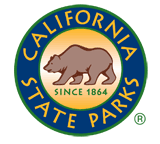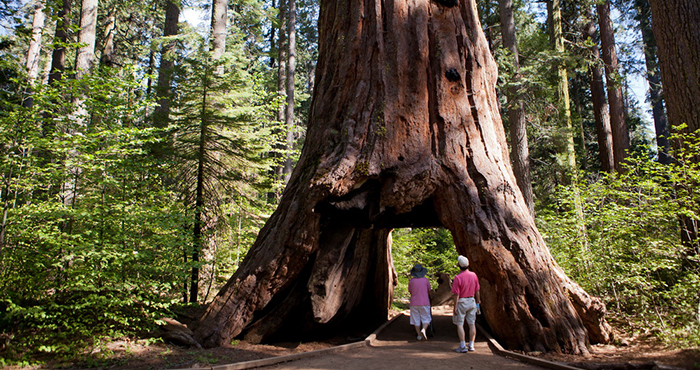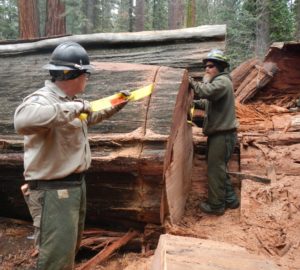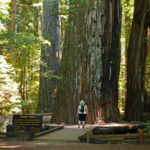Contacts:
Phone: (415) 766-0927 | Email: [email protected]
Phone: 916-651-8725 | Email: [email protected]
Download the full press release
Located within Calaveras Big Trees State Park within a relatively large sequoia grove containing more than 150 specimens estimated to be 2,000 years old, the Pioneer Cabin Tree was one of California’s oldest tourist attractions and a beloved specimen of a rare California native species. A combination of trunk and root decay and storm water runoff appears to have brought the giant sequoia down at its base on January 8, 2017, shattering it and a nearby cedar tree. The Pioneer Cabin Tree stood approximately 205 feet tall and was more than 19 feet in diameter (measured six feet from the ground).
“California’s state parks are endowed with globally, nationally and regionally significant natural resources,” said Heather Reith, Senior Environmental Scientist at Calaveras Big Trees State Park. “Studying the Pioneer Cabin Tree will reveal valuable information about drought, rainfall, historic fire intervals and other climate changes over time that will assist in the long term and sustainable stewardship of these treasured giant sequoias.”
“This iconic ‘tunnel tree’-thousands of years old when it died-has one more story to tell, and it’s all about the dynamic environment that it has occupied throughout its long life,” said Paul Ringgold, Chief Program Officer at Save the Redwoods League. “With the last remaining giant sequoia living in small, scattered groves along California’s Sierra Nevada, it’s important for us to know as much as we can about their life history, so we can all better protect these ancient giants.”
After Carroll has collected and recorded all information, the removed portion of the tree will remain in the park as part of an interpretive display that State Parks and the League will collaboratively design, where its history can live on.
Calaveras Big Trees State Park became a state park in 1931 to preserve the North Grove of giant sequoias. Lightning strikes in the 1800s hollowed out the Pioneer Cabin Tree’s base and later knocked off its crown and opened up its side. In 1881, the Pioneer Cabin Tree base was squared off and enlarged. Similar to Big Stump, the base of the 1850 Discovery Tree at Calaveras Big Trees State Park, the Pioneer Cabin Tree helped visitors experience the enormous size of the ancient sequoias. For 60 years, tourists rode horses and carriages through the Pioneer Cabin Tree, and in the 1920s, automobiles passed through it. Thousands of visitors posed for photos at the tree.
About the Famous Giant Sequoias
The Pioneer Cabin Tree was one of the last of the historic tunnel trees in the Sierra. This giant sequoia fell in January 2017 after a series of heavy storms. The Palace Hotel Tree and Smith Cabin Tree remain standing in the more remote South Grove Nature Preserve at Calaveras Big Trees State Park. The California Tree in Yosemite’s Mariposa Grove of Giant Sequoias and three coast redwood tunnel trees in northwestern California are other storied sequoias in public parks.
Subscribe to California State Parks News via e-mail at [email protected] or via RSS feed (external link).
Subscribe to Save the Redwoods League email to receive the most up-to-date news.
PRESENTING PARTNERS

One of the nation’s oldest conservation organizations, Save the Redwoods League has been protecting and restoring redwood forests since 1918, connecting generations of visitors with the beauty and serenity of the redwood forest. Our 17,000 supporters have enabled the League to protect more than 200,000 acres of irreplaceable forests in 66 state, national and local parks and reserves. For more information, go to SaveTheRedwoods.org.

The California Department of Parks and Recreation provides for the health, inspiration and education of the people of California by helping to preserve the state’s extraordinary biological diversity, protecting its most valued natural and cultural resources, and creating opportunities for high-quality outdoor recreation. Off-highway motor vehicle recreation, boating activities, horseback riding, on- and off-road cycling, hiking, camping, and rock climbing are some of the recreational activities enjoyed in 280 state parks organized into 22 field districts throughout the state. Visit us at parks.ca.gov.
Tags: 2018, california state parks, dendrochronology, Pioneer Cabin Tunnel Tree, Press Release, redwood research, tree rings, Tunnel Tree




